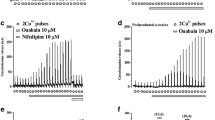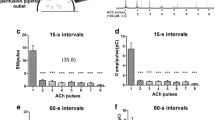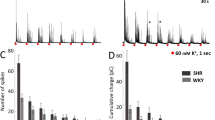Abstract
Gasotransmitter hydrogen sulphide (H2S) has emerged as a regulator of multiple physiological and pathophysiological processes throughout. Here, we have investigated the effects of NaHS (fast donor of H2S) and GYY4137 (GYY, slow donor of H2S) on the exocytotic release of catecholamines from fast-perifused bovine adrenal chromaffin cells (BCCs) challenged with sequential intermittent pulses of a K+-depolarizing solution. Both donors caused a concentration-dependent facilitation of secretion. This was not due to an augmentation of Ca2+ entry through voltage-activated Ca2+ channels (VACCs) because, in fact, NaHS and GYY caused a mild inhibition of whole-cell Ca2+ currents. Rather, the facilitation of exocytosis seemed to be associated to an augmented basal [Ca2+]c and the K+-elicited [Ca2+]c transients; such effects of H2S donors are aborted by cyclopiazonic acid (CPA), that causes endoplasmic reticulum (ER) Ca2+ depletion through sarcoendoplasmic reticulum Ca2+ ATPase inhibition and by protonophore carbonyl cyanide 4-(trifluoromethoxy)phenylhydrazone (FCCP), that impedes the ability of mitochondria to sequester cytosolic Ca2+ during cell depolarization. Inasmuch as CPA and FCCP reversed the facilitation of secretion triggered by K+ in the presence of NaHS and GYY, is seems that such facilitation is tightly coupled to Ca2+ handling by the ER and mitochondria. On the basis of these results, we propose that H2S regulates catecholamine secretory responses triggered by K+ in BCCs by (i) mobilisation of ER Ca2+ and (ii) interference with mitochondrial Ca2+ circulation. In so doing, the clearance of the [Ca2+]c transient will be delayed and the Ca2+-dependent trafficking of secretory vesicles will be enhanced to overfill the secretory machinery with new vesicles to enhance exocytosis.







Similar content being viewed by others
Abbreviations
- H2S:
-
Hydrogen sulphide
- GYY:
-
GYY4137; morpholin-4-ium 4-methoxyphenyl(morpholino) phosphinodithioate; a slow releasing H2S donor
- NaHS:
-
Sodium hydrosulphide; a fast releasing H2S donor
- VACCs:
-
Voltage-activated calcium channels
- DRG:
-
Dorsal root ganglion
References
Abe K, Kimura H (1996) The possible role of hydrogen sulfide as an endogenous neuromodulator. J Neurosci 16:1066–1071
Alonso MT, Barrero MJ, Michelena P, Carnicero E, Cuchillo I, Garcia AG, Garcia-Sancho J, Montero M, Alvarez J (1999) Ca2+-induced Ca2+ release in chromaffin cells seen from inside the ER with targeted aequorin. J Cell Biol 144:241–254
Arnaiz-Cot JJ, de Diego AM, Hernández-Guijo JM, Gandía L, García AG (2008) A two-step model for acetylcholine control of exocytosis via nicotinic receptors. Biochem Biophys Res Commun 365:413–419
Augustine GJ, Neher E (1992) Calcium requirements for secretion in bovine chromaffin cells. J Physiol 450:247–271
Avanzato D, Merlino A, Porrera S, Wang R, Munaron L, Mancardi D (2014) Role of calcium channels in the protective effect of hydrogen sulfide in rat cardiomyoblasts. Cell Physiol Biochem 33:1205–1214
Bian JS, Yong QC, Pan TT, Feng ZN, Ali MY, Zhou S, Moore PK (2006) Role of hydrogen sulfide in the cardioprotection caused by ischemic preconditioning in the rat heart and cardiac myocytes. J Pharmacol Exp Ther 316:670–678
Borges R, Sala F, Garcia AG (1986) Continuous monitoring of catecholamine release from perfused cat adrenals. J Neurosci Methods 16:289–300
Chen YH, Yao WZ, Geng B, Ding YL, Lu M, Zhao MW, Tang CS (2005) Endogenous hydrogen sulfide in patients with COPD. Chest 128:3205–3211
Cuchillo-Ibáñez I, Lejen T, Albillos A, Rose SD, Olivares R, Villarroya M, García AG, Trifaró JM (2004) Mitochondrial calcium sequestration and protein kinase C cooperate in the regulation of cortical F-actin disassembly and secretion in bovine chromaffin cells. J Physiol 560:63–76
Cuchillo-Ibáñez I, Olivares R, Aldea M, Villarroya M, Arroyo G, Fuentealba J, García AG, Albillos A (2002) Acetylcholine and potassium elicit different patterns of exocytosis in chromaffin cells when the intracellular calcium handling is disturbed. Pflugers Arch 444:133–142
de Diego AM, Gandia L, Garcia AGA (2008) Physiological view of the central and peripheral mechanisms that regulate the release of catecholamines at the adrenal medulla. Acta Physiol (Oxf) 192:287–301
de Diego AM, Tapia L, Alvarez RM, Mosquera M, Cortes L, Lopez I, Gutierrez LM, Gandia L, Garcia AG (2008) A low nicotine concentration augments vesicle motion and exocytosis triggered by K+ depolarisation of chromaffin cells. Eur J Pharmacol 598:81–86
De Pascual R, Colmena I, Ruiz-Pascual L, Baraibar AM, Egea J, Gandia L, Garcia AG (2016) Regulation by L channels of Ca2+-evoked secretory responses in ouabain-treated chromaffin cells. Pflugers Arch 468:1779–1792
Douglas WW, Rubin RP (1963) The mechanism of catecholamine release from the adrenal medulla and the role of calcium in stimulus-secretion coupling. J Physiol 167:288–310
Elies J, Scragg JL, Boyle JP, Gamper N, Peers C (2016) Regulation of the T-type Ca2+ channel Cav3.2 by hydrogen sulfide: emerging controversies concerning the role of H2S in nociception. J Physiol 594:4119–4129
Elies J, Scragg JL, Huang S, Dallas ML, Huang D, MacDougall D, Boyle JP, Gamper N, Peers C (2014) Hydrogen sulfide inhibits Cav3.2 T-type Ca2+ channels. FASEB J 28:5376–5387
Eto K, Asada T, Arima K, Makifuchi T, Kimura H (2002) Brain hydrogen sulfide is severely decreased in Alzheimer’s disease. Biochem Biophys Res Commun 293:1485–1488
Fenwick EM, Marty A, Neher E (1982) Sodium and calcium channels in bovine chromaffin cells. J Physiol 331:599–635
Garcia AG, Garcia-De-Diego AM, Gandia L, Borges R, Garcia-Sancho J (2006) Calcium signaling and exocytosis in adrenal chromaffin cells. Physiol Rev 86:1093–1131
García AG, Padín F, Fernández-Morales JC, Maroto M, García-Sancho J (2012) Cytosolic organelles shape calcium signals and exo-endocytotic responses of chromaffin cells. Cell Calcium 51:309–320
Garcia AG, Sala F, Reig JA, Viniegra S, Frias J, Fonteriz R, Gandia L (1984) Dihydropyridine BAY-K-8644 activates chromaffin cell calcium channels. Nature 309:69–71
Garcia-Bereguiain MA, Samhan-Arias AK, Martin-Romero FJ, Gutierrez-Merino C (2008) Hydrogen sulfide raises cytosolic calcium in neurons through activation of L-type Ca2+ channels. Antioxid Redox Signal 10:31–42
García-Sancho J, de Diego AM, García AG (2012) Mitochondria and chromaffin cell function. Pflugers Arch 464:33–41
Giovannucci DR, Hlubek MD, Stuenkel EL (1999) Mitochondria regulate the Ca2+-exocytosis relationship of bovine adrenal chromaffin cells. J Neurosci 19:9261–9270
Goeger DE, Riley RT, Dorner JW, Cole RJ (1988) Cyclopiazonic acid inhibition of the Ca2+-transport ATPase in rat skeletal muscle sarcoplasmic reticulum vesicles. Biochem Pharmacol 37:978–981
Grynkiewicz G, Poenie M, Tsien RYA (1985) New generation of Ca2+ indicators with greatly improved fluorescence properties. J Biol Chem 260:3440–3450
Hamill OP, Marty A, Neher E, Sakmann B, Sigworth FJ (1981) Improved patch-clamp techniques for high-resolution current recording from cells and cell-free membrane patches. Pflugers Arch 391:85–100
Hennig B, Diener M (2009) Actions of hydrogen sulphide on ion transport across rat distal colon. Br J Pharmacol 158:1263–1275
Hildebrandt TM, Grieshaber MK (2008) Three enzymatic activities catalyze the oxidation of sulfide to thiosulfate in mammalian and invertebrate mitochondria. FEBS J 275:3352–3361
Inesi G, Sagara Y (1994) Specific inhibitors of intracellular Ca2+ transport ATPases. J Membr Biol 141:1–6
Jackson-Weaver O, Osmond JM, Riddle MA, Naik JS, Gonzalez Bosc LV, Walker BR, Kanagy NL (2013) Hydrogen sulfide dilates rat mesenteric arteries by activating endothelial large-conductance Ca2+-activated K+ channels and smooth muscle Ca2+ sparks. Am J Physiol Heart Circ Physiol 304:H1446–H1454
Kimura H (2016) Hydrogen polysulfide (H2Sn) signaling along with hydrogen sulfide (H2S) and nitric oxide (NO). J Neural Transm (Vienna) 123:1235–1245
Kombian SB, Reiffenstein RJ, Colmers WF (1993) The actions of hydrogen sulfide on dorsal raphe serotonergic neurons in vitro. J Neurophysiol 70:81–96
Kuksis M, Ferguson AV (2015) Actions of a hydrogen sulfide donor (NaHS) on transient sodium, persistent sodium, and voltage-gated calcium currents in neurons of the subfornical organ. J Neurophysiol 114:1641–1651
Kulkarni KH, Monjok EM, Zeyssig R, Kouamou G, Bongmba ON, Opere CA, Njie YF, Ohia SE (2009) Effect of hydrogen sulfide on sympathetic neurotransmission and catecholamine levels in isolated porcine iris-ciliary body. Neurochem Res 34:400–406
Lee SR, Nilius B, Han J (2018) Gaseous signaling molecules in cardiovascular function: from mechanisms to clinical translation. Rev Physiol Biochem Pharmacol
Lee SW, Hu YS, Hu LF, Lu Q, Dawe GS, Moore PK, Wong PT, Bian JS (2006) Hydrogen sulphide regulates calcium homeostasis in microglial cells. Glia 54:116–124
Leffler CW, Parfenova H, Jaggar JH, Wang R (2006) Carbon monoxide and hydrogen sulfide: gaseous messengers in cerebrovascular circulation. J Appl Physiol (1985) 100:1065–1076
Li L, Moore PK (2008) Putative biological roles of hydrogen sulfide in health and disease: a breath of not so fresh air? Trends Pharmacol Sci 29:84–90
Li L, Rose P, Moore PK (2011) Hydrogen sulfide and cell signaling. Annu Rev Pharmacol Toxicol 51:169–187
Machado JD, Segura F, Brioso MA, Borges R (2000) Nitric oxide modulates a late step of exocytosis. J Biol Chem 275:20274–20279
Marty A, Neher E (1985) Potassium channels in cultured bovine adrenal chromaffin cells. J Physiol 367:117–141
Montero M, Alonso MT, Carnicero E, Cuchillo-Ibáñez I, Albillos A, García AG, García-Sancho J, Alvarez J (2000) Chromaffin-cell stimulation triggers fast millimolar mitochondrial Ca2+ transients that modulate secretion. Nat Cell Biol 2:57–61
Moore PK, Bhatia M, Moochhala S (2003) Hydrogen sulfide: from the smell of the past to the mediator of the future? Trends Pharmacol Sci 24:609–611
Moro MA, Michelena P, Sanchez-Garcia P, Palmer R, Moncada S, Garcia AG (1993) Activation of adrenal medullary L-arginine: nitric oxide pathway by stimuli which induce the release of catecholamines. Eur J Pharmacol 246:213–218
Mustafa AK, Sikka G, Gazi SK, Steppan J, Jung SM, Bhunia AK, Barodka VM, Gazi FK, Barrow RK, Wang R, Amzel LM, Berkowitz DE, Snyder SH (2011) Hydrogen sulfide as endothelium-derived hyperpolarizing factor sulfhydrates potassium channels. Circ Res 109:1259–1268
Nagai Y, Tsugane M, Oka J, Kimura H (2004) Hydrogen sulfide induces calcium waves in astrocytes. FASEB J 18:557–559
Opere CA, Monjok EM, Kulkarni KH, Njie YF, Ohia SE (2009) Regulation of [3H] D-aspartate release from mammalian isolated retinae by hydrogen sulfide. Neurochem Res 34:1962–1968
Padin JF, Fernandez-Morales JC, de Diego AM, Garcia AG (2015) Calcium Channel subtypes and exocytosis in chromaffin cells at early life. Curr Mol Pharmacol 8:81–86
Papapetropoulos A, Pyriochou A, Altaany Z, Yang G, Marazioti A, Zhou Z, Jeschke MG, Branski LK, Herndon DN, Wang R, Szabo C (2009) Hydrogen sulfide is an endogenous stimulator of angiogenesis. Proc Natl Acad Sci U S A 106:21972–21977
Paul BD, Snyder SH (2012) H2S signalling through protein sulfhydration and beyond. Nat Rev Mol Cell Biol 13:499–507
Peers C, Bauer CC, Boyle JP, Scragg JL, Dallas ML (2012) Modulation of ion channels by hydrogen sulfide. Antioxid Redox Signal 17:95–105
Rizzuto R, Marchi S, Bonora M, Aguiari P, Bononi A, De Stefani D, Giorgi C, Leo S, Rimessi A, Siviero R, Zecchini E, Pinton P (2009) Ca2+ transfer from the ER to mitochondria: when, how and why. Biochim Biophys Acta 1787:1342–1351
Rose P, Dymock BW, Moore PK (2015) GYY4137, a novel water-soluble, H2S-releasing molecule. Methods Enzymol 554:143–167
Salvi A, Bankhele P, Jamil JM, Kulkarni-Chitnis M, Njie-Mbye YF, Ohia SE, Opere CA (2016) Pharmacological actions of hydrogen sulfide donors on sympathetic neurotransmission in the bovine anterior uvea, in vitro. Neurochem Res 41:1020–1028
Seidler NW, Jona I, Vegh M, Martonosi A (1989) Cyclopiazonic acid is a specific inhibitor of the Ca2+-ATPase of sarcoplasmic reticulum. J Biol Chem 264:17816–17823
Sitdikova GF, Weiger TM, Hermann A (2010) Hydrogen sulfide increases calcium-activated potassium (BK) channel activity of rat pituitary tumor cells. Pflugers Arch 459:389–397
Szabo C (2007) Hydrogen sulphide and its therapeutic potential. Nat Rev Drug Discov 6:917–935
Tang G, Wu L, Wang R (2010) Interaction of hydrogen sulfide with ion channels. Clin Exp Pharmacol Physiol 37:753–763
Tapia L, Garcia-Eguiagaray J, Garcia AG, Gandia L (2009) Preconditioning stimuli that augment chromaffin cell secretion. Am J Physiol Cell Physiol 296:C792–C800
Telezhkin V, Brazier SP, Cayzac SH, Wilkinson WJ, Riccardi D, Kemp PJ (2010) Mechanism of inhibition by hydrogen sulfide of native and recombinant BKCa channels. Respir Physiol Neurobiol 172:169–178
Testai L, Marino A, Piano I, Brancaleone V, Tomita K, Di Cesare Mannelli L, Martelli A, Citi V, Breschi MC, Levi R, Gargini C, Bucci M, Cirino G, Ghelardini C, Calderone V (2016) The novel H2S-donor 4-carboxyphenyl isothiocyanate promotes cardioprotective effects against ischemia/reperfusion injury through activation of mitoKATP channels and reduction of oxidative stress. Pharmacol Res 113:290–299
Villalobos C, Nunez L, Montero M, Garcia AG, Alonso MT, Chamero P, Alvarez J, Garcia-Sancho J (2002) Redistribution of Ca2+ among cytosol and organella during stimulation of bovine chromaffin cells. FASEB J 16:343–353
Villarroya M, Olivares R, Ruiz A, Cano-Abad MF, de Pascual R, Lomax RB, Lopez MG, Mayorgas I, Gandia L, Garcia AG (1999) Voltage inactivation of Ca2+ entry and secretion associated with N- and P/Q-type but not L-type Ca2+ channels of bovine chromaffin cells. J Physiol 516(Pt 2):421–432
Vitvitsky V, Kabil O, Banerjee R (2012) High turnover rates for hydrogen sulfide allow for rapid regulation of its tissue concentrations. Antioxid Redox Signal 17:22–31
von Ruden L, Neher E (1993) A Ca-dependent early step in the release of catecholamines from adrenal chromaffin cells. Science 262:1061–1065
Wang R (2010) Hydrogen sulfide: the third gasotransmitter in biology and medicine. Antioxid Redox Signal 12:1061–1064
Wang R (2012) Physiological implications of hydrogen sulfide: a whiff exploration that blossomed. Physiol Rev 92:791–896
Webb GD, Lim LH, Oh VM, Yeo SB, Cheong YP, Ali MY, El Oakley R, Lee CN, Wong PS, Caleb MG, Salto-Tellez M, Bhatia M, Chan ES, Taylor EA, Moore PK (2008) Contractile and vasorelaxant effects of hydrogen sulfide and its biosynthesis in the human internal mammary artery. J Pharmacol Exp Ther 324:876–882
Wilkinson WJ, Kemp PJ (2011) Carbon monoxide: an emerging regulator of ion channels. J Physiol 589:3055–3062
Zhang YX, Hu KD, Lv K, Li YH, Hu LY, Zhang XQ, Ruan L, Liu YS, Zhang H (2015) The hydrogen sulfide donor NaHS delays programmed cell death in barley aleurone layers by acting as an antioxidant. Oxidative Med Cell Longev 2015:714756
Zhou Z, Neher E (1993) Mobile and immobile calcium buffers in bovine adrenal chromaffin cells. J Physiol 469:245–273
Zhu D, Yu X, Sun J, Li J, Ma X, Yao W (2012) H2S induces catecholamine secretion in rat adrenal chromaffin cells. Toxicology 302:40–43
Funding
Supported by grants from MINECO, Spain (SAF 2013-44108-P and SAF 2016-78892-R). Also by CABYCIC UAM/Bioibérica and Nutrinfant UAM/Alter, Spain. The authors also thank the continued support of Fundación Teófilo Hernando, Madrid, Spain.
Author information
Authors and Affiliations
Corresponding author
Electronic supplementary material
Supplementary Fig. 1
Compounds NaHS and GYY do not affect inward sodium currents (INa). a, c Original INa traces obtained in BCCs that where voltage-clamped at − 80 mV, following the protocol on the top (test depolarizing pulses of 10-ms duration applied at 10-s intervals). Traces were obtained before (control), after 2 min in the presence of 100 μM each of NaHS or GYY, and 3 min after washout of the compounds (WO). b, d Averaged pooled data (mean ± SEM) of the number of experiments shown in parentheses (number of cells and cultures). (JPG 430 kb)
Supplementary Fig. 2
Mild cell depolarization of BCCs produced by NaHS, but not by GYY. Membrane potential (Vm) was recorded under the current-clamp configuration of the patch-clamp technique. a, d Vm recording from two example cells exposed to NaHS (a) or GYY (d) during the time period indicated by the horizontal bar. b, c, e, f Pooled data in control conditions, after 2-min exposure to 100 or 300 μM NaHS (b, c) or GYY (e, f), and after compounds washout. Data are means ± SEM of the number of cells and cultures given in parentheses. *p < 0.05, *** p < 0.001 with respect to control currents (JPG 403 kb)
Supplementary Fig. 3
Evoked action potentials (APs) are modified by NaHS, but not by GYY. Single APs were evoked by threshold depolarisations in current-clamped BCCs. a, d AP traces obtained in example cells before (control) and 1 min after cell exposure to NaHS (a) or GYY (d). b, c, e, f Pooled data on the normalised AP peak amplitude and after-hyperpolarisation (AHP). Data are means ± SEM of the number of cells and cultures shown in parentheses. *p < 0.05, ***p < 0.001, compared with control (JPG 617 kb)
Supplementary Fig. 4
Monitoring of the cytosolic Ca2+ concentrations ([Ca2+]c) in BCC populations plated in 96-well black plates and loaded with fura-2-AM. The use in these experiments of fura-2 allowed the conversion of arbitrary fluorescence units into nM [Ca2+] (ordinates). Averaged basal [Ca2+]c varied from around 75 to 120 nM. In order to compare traces (a), the initial basal fluorescence has been subtracted. Therefore, values in this panel are actually Δ[Ca2+]c (ordinates). NaHS at the final concentrations (μM) shown in each curve elicited a gradual increase of [Ca2+]c that reached a similar plateau at the three concentrations tested. b Time course of the variation of [Ca2+]c in cells exposed first to NaHS (10 μM) and after 3 min, to cyclopiazonic acid (CPA, 10 μM) added on top of NaHS. c [Ca2+]c elevations produced by adding first CPA (10 μM); 3 min later, NaHS (10 μM) was added on top of CPA. Data shown in all panels are averages of 3–5 experiments. (JPG 444 kb)
Rights and permissions
About this article
Cite this article
de Pascual, R., Baraibar, A.M., Méndez-López, I. et al. Hydrogen sulphide facilitates exocytosis by regulating the handling of intracellular calcium by chromaffin cells. Pflugers Arch - Eur J Physiol 470, 1255–1270 (2018). https://doi.org/10.1007/s00424-018-2147-7
Received:
Revised:
Accepted:
Published:
Issue Date:
DOI: https://doi.org/10.1007/s00424-018-2147-7




